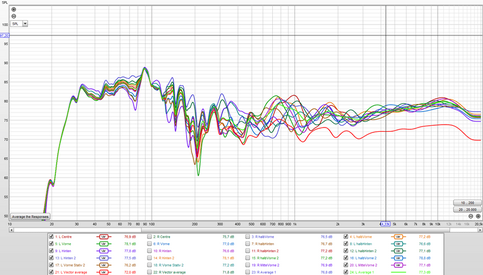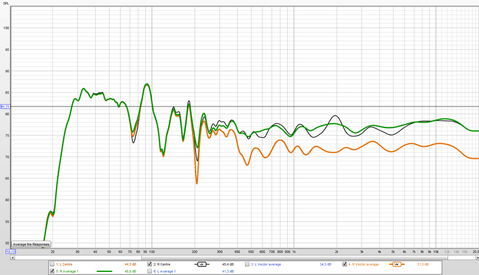JoachimStrobel
New Member
Thread Starter
- Joined
- Jun 20, 2019
- Posts
- 49
More
- Preamp, Processor or Receiver
- Parasound PSP 1500, NanoAvr HDA
- Main Amp
- Parasound HCA 1200
- Additional Amp
- 2x Parasound HCA 1000
- Universal / Blu-ray / CD Player
- Oppo 103D, Parasound CDP1000 & DAC2000
- Front Speakers
- Canton RCL
- Center Channel Speaker
- 2x Canton RCL
- Surround Speakers
- Canton RCL
- Video Display Device
- BenQ Beamer
I have taken 10 measurements for each loudspeaker around my listening position, using a 20sec 10-20Khz sweep with default windowing (no FDW)
I have done an RMS and an Vector average and wonder about the difference. I am sure it has to do with the phase and am looking for a simple explanation and how to move forward.
I show all the measurements for the left channel below, the RMS average is in lime, the vector average is in red, some lower.

I am showing the averages again to be seen more clearly. I added the centre LP in black

Moving forward into EQ, I assume that I use the RMS average, but then I have no phase information, is that right? To move into RePhase, I would use the vector average. This seems kind of Ok if I stay blow 200 Hz (avoiding the large room mode) as all curves are the same there. However, I might want to do an EQ up to 13Khz as I am relatively close to the speakers and they are hence a bit too bright (and I might try to do some other stuff with HF EQ later).
I want to try that in REW first and then later in RePhase. As the averages above 1Khz differ almost by 10 dB, the EQ results will be different. So, which is the correct one to use? Or does the difference show, that I do have problems with the phase, and I should rather not attempt Eqing above 200 Hz?
On another line of though, I noticed that the centre measurements fit the RMS average quite well (after removing the two extreme measurements that are behinm my LP close to a tilted roof) and of course still contains phase information. Should I rather skip averaging and simply use that centre LP measurement?
I am thankful for any comments.
(The filters will be used in ROON)
I have done an RMS and an Vector average and wonder about the difference. I am sure it has to do with the phase and am looking for a simple explanation and how to move forward.
I show all the measurements for the left channel below, the RMS average is in lime, the vector average is in red, some lower.
I am showing the averages again to be seen more clearly. I added the centre LP in black
Moving forward into EQ, I assume that I use the RMS average, but then I have no phase information, is that right? To move into RePhase, I would use the vector average. This seems kind of Ok if I stay blow 200 Hz (avoiding the large room mode) as all curves are the same there. However, I might want to do an EQ up to 13Khz as I am relatively close to the speakers and they are hence a bit too bright (and I might try to do some other stuff with HF EQ later).
I want to try that in REW first and then later in RePhase. As the averages above 1Khz differ almost by 10 dB, the EQ results will be different. So, which is the correct one to use? Or does the difference show, that I do have problems with the phase, and I should rather not attempt Eqing above 200 Hz?
On another line of though, I noticed that the centre measurements fit the RMS average quite well (after removing the two extreme measurements that are behinm my LP close to a tilted roof) and of course still contains phase information. Should I rather skip averaging and simply use that centre LP measurement?
I am thankful for any comments.
(The filters will be used in ROON)














